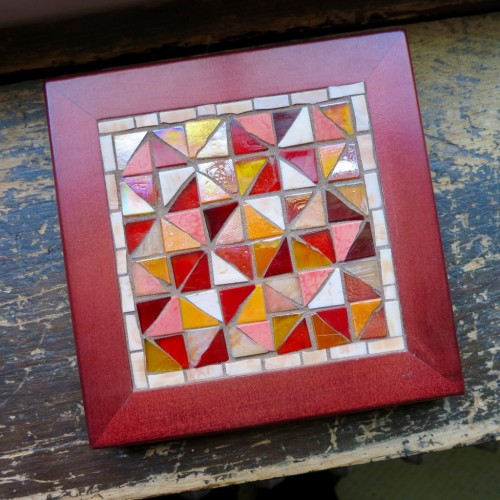No dishes were harmed in the making of this quilt block trivet. Broken Dishes is one of my favorite quilt patterns, and I enjoy the fact that I use only glass tile in creating the design in mosaic. There is a form of mosaic, Pique Assiette, that is made entirely from broken dishes. Glass is my love. The creative spirit incarnates in many different forms and mediums, and for a long time I thought I loved sewing, when in fact what I loved was fabric and pattern.
I keep this award for junior high Home Economics in my studio as a reminder of two things: 1)Just because you are good at something doesn’t mean you have to do it and 2)Creative energies get shepherded into available enclosures. For awhile, somewhere between grade 8 and grade 9, I thought I wanted to be a Home Ec teacher. I’ve wondered who Adele Swensen was. When I looked her up a blog post I’d written in 2007, on a long-forgotten blog, appeared. I thought I would share some of it here:
I was the girl who had a talent for reading pattern instructions. I would read anything. Reading was my drug for the pain of junior high, and this compulsion came in handy in Home Ec. Most of the other girls didn’t read the instruction sheet, or didn’t understand it, and would ask the teacher what to do next. This puzzled me; asking a question was not something I ever considered. This is the irony that I became a Reference Librarian, without ever having asked a Librarian a question. I expected myself to know before knowing, to know everything in advance.
In Home Ec, the feeling of power that came from comprehending the instructions and answering other girls’ questions inspired me to tell my parents I wanted to become a Home Economics teacher. This was definitely “not to my potential.” Yes, one could major in Home Ec at the University, but there was an unspoken belief that cooking and sewing were not truly academic subjects, but women’s work.
The confounding factor was that sewing made me cry. All manner of emotional pain could not bring the tears, but a crooked seam, or a ratty looking bobbin thread could bring me to sobs. I loved the big pattern books on the tilted tables. I loved fabric, the texture and colors. I loved that weaves had names like herringbone, and that they were identifiable. I loved notions like zippers and buttons and thread. I loved the smell of sewing machine oil and the line drawings on newsprint illustrating each step of construction. But actual sewing tested my limits: I wanted it exactly right. I saw flaws that no one else did, which made me well acquainted with my seam ripper(which in spite of its association with imperfection, was still a lovely notion).
I felt I should want to to sew, that the Adele Swensen award meant something about my destiny. As an adult, I went through a time of wanting to make quilts, circling back to the sewing machine that tormented me. I finally had the revelation that I did not like sewing. I loved quilts, but to actually make one, no. Instead my husband decided he wanted to continue his grandmother’s legacy and learn to quilt and I gave him my sewing machine. His keen spatial abilities allowed him to align seams with precision.
That year I made Christmas cards in a log cabin quilt design with magazine papers in red and green, and it was a delight. And then when I started making mosaics, I made quilt designs in glass, and this was even more delightful! This is what happens when you discover your medium. Not that I don’t ever get frustrated, but the joy outweighs it. The impulse to make something beautiful can be incarnated in many forms. *Women’s work* has what beauty has arisen from it, needlework, sewing, quilting. A quilt is often the only legacy from women in our family histories,their biography in cloth, and I hope to write mine in glass.


